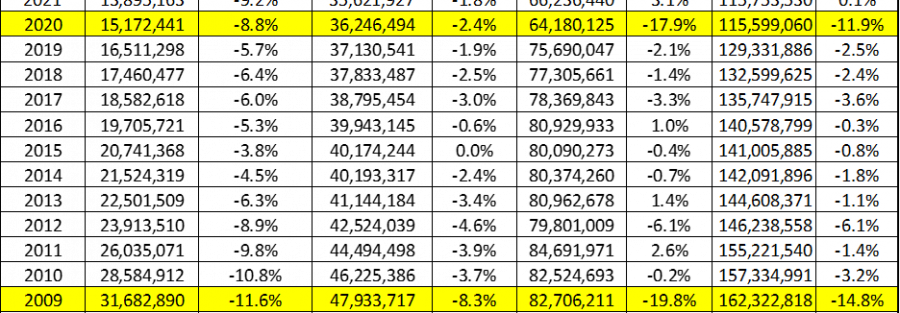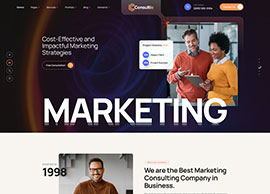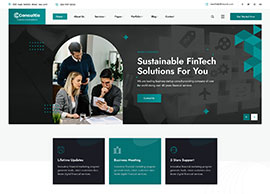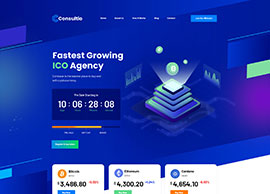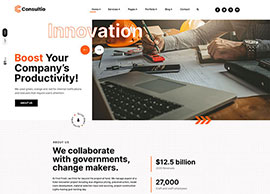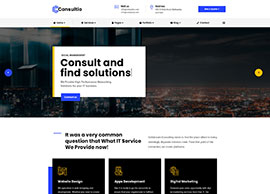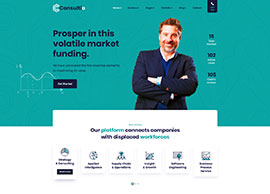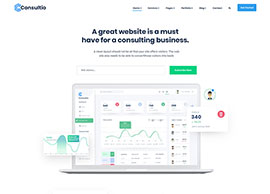Everything you hear on the news is how mail is going away and becoming less relevant as a means of communication. The objective of this article is to explain what is actually happening today and where mail will go in the future. We are basing this on 29 years of industry experience, working with thousands of the nation’s top mailers.
Summary by Year
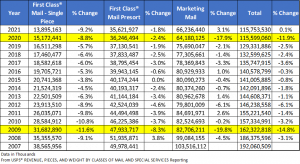
The USPS® breaks mail down into two mail categories:
- Market Dominant (Where clients do not have any other options such as letters and flats)
- Competitive (Parcels) where they can use other providers like UPS® and FedEx®.
We are going to focus this article on the Market Dominant mail classes. It is also important to note, that the USPS processed 121,605,997 pieces of Market Dominant vs. the growing Competitive Parcel segment that only processed 7,254,759. We are also going to focus on the main mail classes excluding Periodicals and Retail Package Services.
First Class® Mail – Single Piece – Change in Volume – 1 Year -9.2%, 5 Year -29%, 10 Year – 47%
If there was one class of mail worthy of the negative press, it would be this category that is made up of personal and business mail. We are all sending fewer personal letters and paying bills electronically that is making an impact.
There are also over 32 million businesses in the United States and the majority will use the Postal Service at some point. The big issue is the main items that used to be sent have moved to electronic and this trend will continue.
- Invoices/Statements – This is the number one item that is mailed by businesses, and more are moving to email and web presentment. Larger organizations are getting smarter about consolidating or outsourcing this mail and moving to the First Class® Mail Presort category due to its lower postage rates.
- Checks – Many payments are moving to electronic ACH due to the speed and simplicity. Payroll checks and direct deposit statements have been eliminated at most companies forcing employees to access data on the web.
- Marketing Mailings – Many companies used to sit around a table and prepare promotional mailings, but this has been almost eliminated in the office environment. This mail has either converted to email marketing or has been sent to an outsource provider who has the proper equipment and staff to get the mail sent more efficiently at lower postage rates.
- Day to Day Mail – This is the final category that makes up the miscellaneous items that need to be sent out. This volume will continue to decline as more items are accepted electronically.
Future Predictions – Mail volumes will continue to decline at 6-9% annually. The trends listed above will continue.
Mailing Technology – As mail volumes decline, there is less of a need for larger equipment and there will be a continual migration to smaller postage meters and online postage solutions. The transition to work from home due to Covid-19 has pushed online solutions at faster rates. There is also a change in postal compliance where approximately 70% of the nation’s postage meters will need to be updated by 2024. This will cause more clients to look for online solutions that are flexible and provide better postage discount opportunities. There will be a huge growth in enterprise based online postage solutions where a company can control the postage spends for all its locations and users no matter where they are located.
First Class® Mail Presort – Change in Volume – 1 Year -1.8%, 5 Year -11%, 10 Year – 20%
The presort class is used because it offers postal discounts over the single piece class discussed above. There are two main segments of this mail class.
- In-House Produced Mail – Companies will either have automation software in-house that can qualify the mail for this class or more commonly they will use a third party presort service that will come pick up their mail and split the discounts.
- Outsourced Mail – Mail is sent to an organization that specializes in mail production to get the piece sent out more efficiently.
The slowest declines have been in this segment with volumes only going down 20% (vs. 47% for single piece) over the last 10 years. The reason for this is there has been a slower than expected adoption for accepting bills and statements electronically. Also, specific industries are regulated to send items unless the client accepts electronic substitution. Examples include financial, insurance, healthcare and government that make up a huge percentage of this volume.
Future Predictions – This space will see similar declines unless there are new laws passed that allow businesses to migrate clients to electronic without consent. There have been different attempts at digital mailboxes, and all have failed and we do not expect any breakthrough technologies over the next 5 years that would change this. There is new technology that allows smaller mailings to be sent electronically to production facilities to be created in automated workflows. This will further reduce single piece quantities and move volumes to Presort. It will also make it easier for smaller mailings to be sent along with production volumes.
Marketing Mail – Change in Volume – 1 Year .1%, 5 Year -18%, 10 Year – 22%
This is the largest single class of mail and is used because it is the least expensive way to send a document. The criteria are that mailings need to be uniform where everyone is getting the same message and lack any significant personalization that would require it to be sent at the more expensive First-Class® rates. The fact that this is the largest category should not be surprising as when most people open their mailboxes, most items are solicitations and catalogs.
Changes in the economy create huge impacts in this category. With the recession in 2009 we saw a 14.8% decline and again when Covid-19 hit in 2020, we saw an 11.9% reduction. When we have these large corrections, people expect volumes to increase in future years, but this has not occurred and the volume resets to the new normal.
Over the years, people have expected Marketing Mail to drop off in favor of electronic mediums. This has not happened because of the unique ways mail can get a message to its desired recipient. Digital mediums can all be blocked by spam filters and do not subscribe lists. People are not watching commercials on TV with DVR’s and subscription streaming services. We do not listen to radio as much due to audio streaming services and no one wants to be called by solicitors while having dinner. Mail is still a trusted medium where we can get targeted messages that has proven effective by marketers.
Future Predictions – We will see annual declines at similar rates. Mail will become more targeted with smaller volumes and higher levels of segmentation with improved data and analytics. Marketing Mail will become more accessible to small business with new web-based submission platforms that will make it easier to create mailings at lower costs.
Conclusion
When you look at business mail, we are seeing a few main themes:
- Essential mail is moving electronic but at a slow rate.
- Mail is becoming more efficient, moving away from single piece to other discount mail classes.
- Promotional targeted mail is still an effective means to reach clients, but generic content like newsletters and announcements are moving to email.
- Technology is moving to the cloud where mail can be generated either physically with online postage or can be moved to production facilities where it can be sent in the most efficient ways.
All these changes are designed to reduce the cost to the mailers and have the messages received in the most efficient manner.

